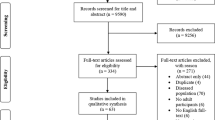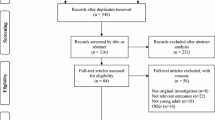Abstract
Background
Few studies have examined the relationships between walking speed and gait cycle variability, and muscle strength and postural stability, with a focus on gender differences.
Aim
The aim of this study was to examine whether there are different factors affecting walking speed and gait cycle variability between men and women in community-dwelling older adults.
Methods
The subjects comprised 712 community-dwelling older adults (252 men, 460 women, aged 68.7 ± 4.8 years). Walking speed and coefficient of variation (CV) of step time at a comfortable walking pace were measured. The maximal isometric strength of six lower limb muscles and postural stability were evaluated. Stepwise regression analysis was performed, using lower limb muscle strength and postural stability as independent variables, to investigate the association with walking speed or CV.
Results
For older men, age, body mass index (BMI) and quadriceps setting (QS) strength were significant and independent determinants of walking speed. No variables were identified as significant determinants of CV. For older women, BMI and hip flexion, hip abduction, QS muscle strength were significant determinants of walking speed. Only hip abduction strength was a significant determinant of CV.
Discussion
The results of this study suggest that QS strength is related to walking speed in both men and women, whereas hip flexion and abduction muscle strength are related to walking speed, and hip abduction muscle strength is related to gait cycle variability in older women.
Conclusion
Gender differences exist in factors affecting walking speed and gait cycle variability in community-dwelling older adults.


Similar content being viewed by others
References
Vellas B, Cayla F, Bocquet H et al (1987) Prospective study of restriction of activity in old people after falls. Age Ageing 16:189–193. doi:10.1093/ageing/16.3.189
Kannus P, Sievänen H, Palvanen M et al (2005) Prevention of falls and consequent injuries in elderly people. Lancet 366:1885–1893. doi:10.1016/S0140-6736(05)67604-0
Talbot LA, Musiol RJ, Witham EK et al (2005) Falls in young, middle-aged and older community dwelling adults: perceived cause, environmental factors and injury. BMC Public Health 5:86. doi:10.1186/1471-2458-5-86
Niino N, Tsuzuku S, Ando F et al (2000) Frequencies and circumstances of falls in the National Institute for Longevity Sciences, Longitudinal Study of Aging (NILS-LSA). J Epidemiol 10:S90–S94. doi:10.2188/jea.10.1sup_90
Verghese J, Holtzer R, Lipton RB et al (2009) Quantitative gait markers and incident fall risk in older adults. J Gerontol A Biol Sci Med Sci 64:896–901. doi:10.1093/gerona/glp033
Mortaza N, Abu Osman NA, Mehdikhani N (2014) Are the spatio-temporal parameters of gait capable of distinguishing a faller from a non-faller elderly? Eur J Phys Rehabil Med 50:677–691. http://www.ncbi.nlm.nih.gov/pubmed/24831570
Hausdorff JM, Rios DA, Edelberg HK (2001) Gait variability and fall risk in community-living older adults: a 1-year prospective study. Arch Phys Med Rehabil 82:1050–1056. doi:10.1053/apmr.2001.24893
Bohannon RW (1997) Comfortable and maximum walking speed of adults aged 20–79 years: reference values and determinants. Age Ageing 26:15–19. doi:10.1093/ageing/26.1.15
Tiedemann A, Sherrington C, Lord SR (2005) Physiological and psychological predictors of walking speed in older community-dwelling people. Gerontology 51:390–395. doi:10.1159/000088703
Ringsberg K, Gerdhem P, Johansson J et al (1999) Is there a relationship between balance, gait performance and muscular strength in 75-year-old women? Age Ageing 28:289–293. doi:10.1093/ageing/28.3.289
Hayashida I, Tanimoto Y, Takahashi Y et al (2014) Correlation between muscle strength and muscle mass, and their association with walking speed, in community-dwelling elderly Japanese individuals. PLoS One 9:e111810. doi:10.1371/journal.pone.0111810
Callisaya ML, Blizzard L, Schmidt MD et al (2009) A population-based study of sensorimotor factors affecting gait in older people. Age Ageing 38:290–295. doi:10.1093/ageing/afp017
Bendall MJ, Bassey EJ, Pearson MB (1989) Factors affecting walking speed of elderly people. Age Ageing 18:327–332. doi:10.1093/ageing/18.5.327
Callisaya ML, Blizzard L, McGinley JL et al (2010) Sensorimotor factors affecting gait variability in older people-a population-based study. J Gerontol A Biol Sci Med Sci 65A:386–392. doi:10.1093/gerona/glp184
Hausdorff JM, Nelson ME, Kaliton D et al (2001) Etiology and modification of gait instability in older adults: a randomized controlled trial of exercise. J Appl Physiol 90:2117–2129
Matsuda K, Ikeda S, Nakahara M et al (2015) Factors affecting the coefficient of variation of stride time of the elderly without falling history: a prospective study. J Phys Ther Sci 27:1087–1090. doi:10.1589/jpts.27.1087
Bohannon RW (1997) Reference values for extremity muscle strength obtained by hand-held dynamometry from adults aged 20 to 79 years. Arch Phys Med Rehabil 78:26–32. doi:10.1016/S0003-9993(97)90005-8
Stoll T, Huber E, Seifert B et al (2000) Maximal isometric muscle strength: normative values and gender-specific relation to age. Clin Rheumatol 19:105–113. doi:10.1007/s100670050026
Seino S, Shinkai S, Fujiwara Y et al (2014) Reference values and age and sex differences in physical performance measures for community-dwelling older Japanese: a pooled analysis of six cohort studies. PLoS One 9:e99487. doi:10.1371/journal.pone.0099487
Ostchega Y, Harris TB, Hirsch R et al (2000) Reliability and prevalence of physical performance examination assessing mobility and balance in older persons in the US: data from the Third National Health and Nutrition Examination Survey. J Am Geriatr Soc 48:1136–1141. doi:10.1111/j.1532-5415.2000.tb04792.x
Merrill SS, Seeman TE, Kasl SV et al (1997) Gender differences in the comparison of self-reported disability and performance measures. J Gerontol A Biol Sci Med Sci 52:M19–M26. doi:10.1093/gerona/52A.1.M19
Ishizaki T, Furuna T, Yoshida Y et al (2011) Declines in physical performance by sex and age among nondisabled community-dwelling older Japanese during a 6-year period. J Epidemiol 21:176–183. doi:10.2188/jea.JE20100138
Deandrea S, Lucenteforte E, Bravi F et al (2010) Risk factors for falls in community-dwelling older people: a systematic review and meta-analysis. Epidemiology 21:658–668. doi:10.1097/EDE.0b013e3181e89905
Brito TA, Coqueiro RDS, Fernandes MH et al (2014) Determinants of falls in community-dwelling elderly: hierarchical analysis. Public Health Nurs 31:290–297. doi:10.1111/phn.12126
Stevens JA, Sogolow ED (2005) Gender differences for non-fatal unintentional fall related injuries among older adults. Inj Prev 11:115–119. doi:10.1136/ip.2004.005835
Nakayama T (2010) Implementation of a genomic epidemiology and public health activities in a community: establishing a “rule” for the protection and utilization of individual information. Jap J Genet Couns 31:117–121. http://mol.medicalonline.jp/library/journal/download?GoodsID=dg8genco/2010/003103/001&name=0117-0121j&UserID=130.54.130.244
Lacour M, Barthelemy J, Borel L et al (1997) Sensory strategies in human postural control before and after unilateral vestibular neurotomy. Exp Brain Res 115:300–310. doi:10.1007/PL00005698
Isableu B, Ohlmann T, Crémieux J et al (2003) Differential approach to strategies of segmental stabilisation in postural control. Exp Brain Res 150:208–221. doi:10.1007/s00221-003-1446-0
Cooper R, Hardy R, Sayer A et al (2011) Age and gender differences in physical capability levels from mid-life onwards: the harmonisation and meta-analysis of data from eight UK cohort studies. PLoS One 6:e27899. doi:10.1371/journal.pone.0027899
Callisaya ML, Blizzard L, Schmidt MD et al (2010) Ageing and gait variability—a population-based study of older people. Age Ageing 39:191–197. doi:10.1093/ageing/afp250
Gallagher D, Visser M, Meersman REDE et al (1997) Appendicular skeletal muscle mass: effects of age, gender, and ethnicity. J Appl Physiol 83:229–239
Baumgartner RN, Waters DL, Gallagher D et al (1999) Predictors of skeletal muscle mass in elderly men and women. Mech Ageing Dev 107:123–136. doi:10.1016/S0047-6374(98)00130-4
Simoneau JA, Bouchard C (1989) Human variation in skeletal muscle fiber-type proportion and enzyme activities. Am J Physiol 257:E567–E572
Costill DL, Daniels J, Evans W et al (1976) Skeletal muscle enzymes and fiber composition in male and female track athletes. J Appl Physiol 40:149–154
Era P, Sainio P, Koskinen S et al (2006) Postural balance in a random sample of 7979 subjects aged 30 years and over. Gerontology 52:204–213. doi:10.1159/000093652
Omori G, Koga Y, Tanaka M et al (2013) Quadriceps muscle strength and its relationship to radiographic knee osteoarthritis in Japanese elderly. J Orthop Sci 18:536–542. doi:10.1007/s00776-013-0383-4
Andersen LL, Magnusson SP, Nielsen M et al (2006) Neuromuscular activation in conventional therapeutic exercises and heavy resistance exercises: implications for rehabilitation. Phys Ther 86:683–697. http://www.ncbi.nlm.nih.gov/pubmed/16649892
Perry J (2010) Gait analysis: normal and pathological function. SLACK, Thorofare
Judge JO, Davis RB, Ounpuu S (1996) Step length reductions in advanced age: the role of ankle and hip kinetics. J Gerontol A Biol Sci Med Sci 51:M303–M312
MacKinnon CD, Winter DA (1993) Control of whole body balance in the frontal plane during human walking. J Biomech 26:633–644. doi:10.1016/0021-9290(93)90027-C
Neptune RR, Kautz SA, Zajac FE (2001) Contributions of the individual ankle plantar flexors to support, forward progression and swing initiation during walking. J Biomech 34:1387–1398. doi:10.1016/S0021-9290(01)00105-1
Author information
Authors and Affiliations
Corresponding author
Ethics declarations
Conflict of interest
On behalf of all authors, the corresponding author states that there is no conflict of interest.
Ethical approval
All procedures performed in studies involving human participants were in accordance with the ethical standards of the institutional and/or national research committee and with the 1964 Helsinki declaration and its later amendments or comparable ethical standards. All study procedures were approved by the ethics committee of Kyoto University Graduate School of Medicine and by the Nagahama Municipal Review Board.
Informed consent
Informed consent was obtained from all the participants included in the study.
Rights and permissions
About this article
Cite this article
Inoue, W., Ikezoe, T., Tsuboyama, T. et al. Are there different factors affecting walking speed and gait cycle variability between men and women in community-dwelling older adults?. Aging Clin Exp Res 29, 215–221 (2017). https://doi.org/10.1007/s40520-016-0568-8
Received:
Accepted:
Published:
Issue Date:
DOI: https://doi.org/10.1007/s40520-016-0568-8




